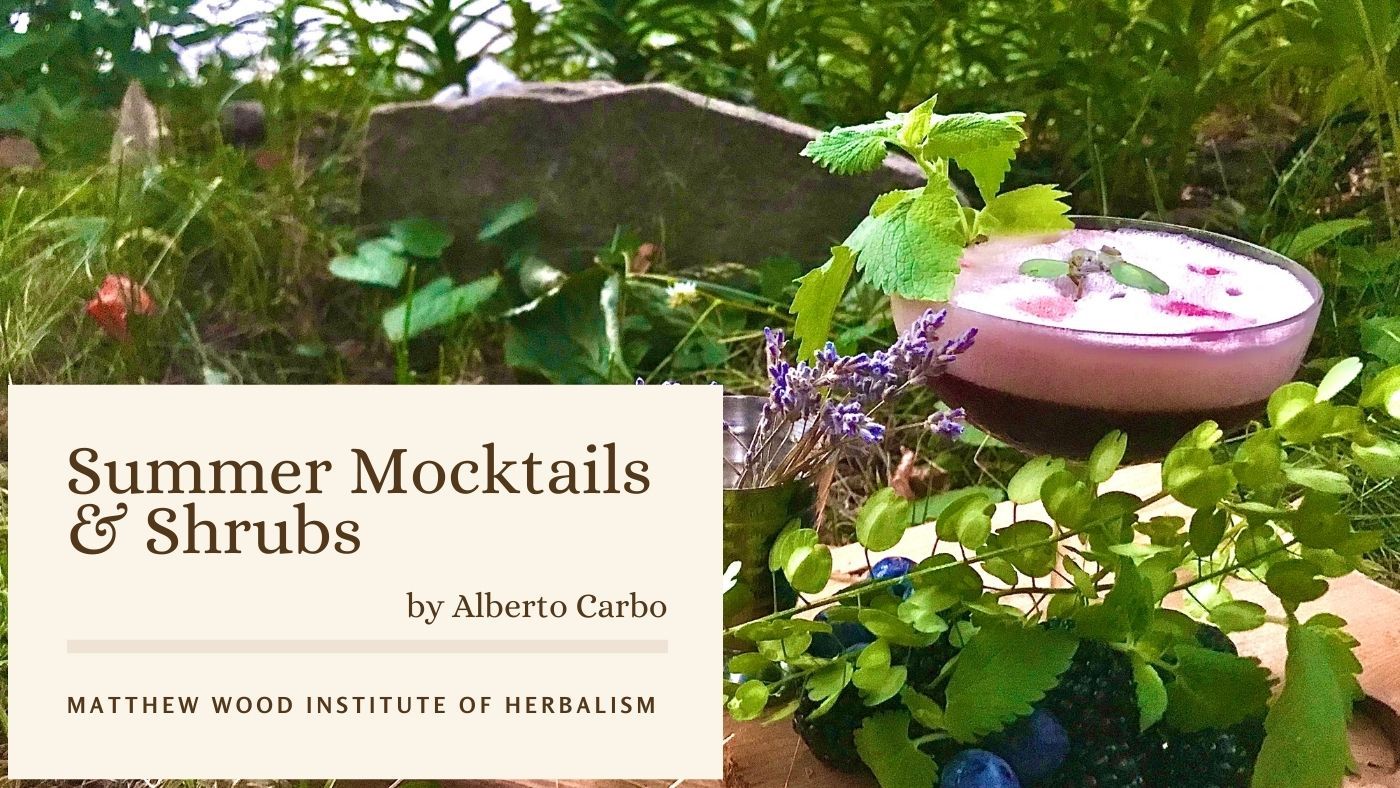Jump to Recipe
As a former chef/bartender, I am frequently asked about cocktails and mocktails. Much of the time, it seems as though people are intimidated and unsure about how to proceed when in reality, it is quite a simple process, and if you are in any way creative, crafting delicious beverages will likely come as second nature to you.
Rather than simply providing a recipe, I’d like to empower and inspire you with the basics, so that you can engage your creative abilities and create your own unique flavor profiles, all of course with the goal of further incorporating medicinal plants into our diets.
The only thing you really need to know in order to create a well-balanced and rounded mocktail/cocktail is the following formula:
- Base – The main ingredient, and usually a spirit, however, when making alcohol-free beverages we can substitute something like a shrub, a cordial, or even an herbal infusion.
- Modifier – As the name suggests, this is a substance that is meant to modify, and rather enhance the flavor profile of the base ingredient. Also, usually a spirit, however as above, can be substituted for a non-alcoholic option.
- Acid – Lemon and lime are the most common, but the possibilities are endless, and as long as the flavor is tart/sour, it’s a viable option. Tart tropical fruit purées or juices are a great alternative.
- Sweetener – Usually a syrup or raw sugar, but honey, stevia, agave, and other alternative sweeteners also work.
- Bitter – Classically bitters are used, such as Angostura and Peychaud’s, however, plant lovers should have no issue thinking of alternatives either in tincture format, or fresh plant material.
There are so many directions to go from here, but for the sake of practicality, I am going to concentrate on shrubs as one incredible non-alcoholic ‘base’, so that you can start creating your own refreshing beverages.
Shrubs were a staple and even medicine in a time before food preservatives, refrigeration, and commercially sold carbonated beverages, but unfortunately were largely forgotten, until the last two decades when bartenders became interested in them.
Not only are shrubs a great way to preserve fruit and other fresh perishables, but they are also a delicious and dynamic addition to many different types of beverages. The reason they were so popular, and frankly, the reason for which they should continue to be is the same: shrubs are an ingenious way of reducing waste and making the best of the growing season.
They are also a great creative outlet for the already culinarily inclined, as well as a great starting point for those who are just beginning to explore culinary creations, like kids!
If you are a parent, it is also a fantastic way to sneak as much flavonoid and vitamin-rich fruit into your child’s diet during the summer months, and into the colder seasons, disguised by wonderful aromas and flavors, as well as the fizzy bubbly textures kids gravitate to. Although sugar is a popular ingredient in shrubs, you can pick what kind of sugar to use, and even substitute it with honey, maple syrup, or alternative sweeteners. Definitely no aspartame in here!
Shrubs are a fantastic way to explore herbal actions as well. (You can learn more about exploring herbal actions in the free intro to Medicine Making, Tasting and Sensing Herbs
Looking back in history far enough, we find that shrubs were used medicinally in the 1400s to prevent and remedy scurvy. Shrubs were popular amongst sailors and in countries where vitamin-rich fruit was not available all year round. Even further back, we know that ancient cultures added vinegar to their water to maintain its portability.
The abundance of fresh fruit in the summer season is certainly a blessing, but can also be overwhelming to keep up with. Although pies and jams are irreplaceable (yum!), shrubs add yet another option for embracing the abundance of summer, especially since you can use fruit and veggies which are no longer appealing to eat. As long as there is no mold on the fruit/veggies you are going to use, they are fair game, and in fact, these ‘past due’ perishables are ideal, as they help kick-start the fermentation process.
While I am providing a recipe, you will quickly learn you can’t go wrong with shrubs. You will find your preferred ingredients, or perhaps the ingredients that are abundantly in season, and through tasting and trying, come up with wonderful combinations.
Blackberry, Blueberry Shrub with Peppergrass & Catnip
There are endless variations of shrubs. Imagine an apple cinnamon cardamom shrub, or a peach & toasted pecan shrub. You can also make savory shrubs such as a cucumber, dill, and radish shrub, or a tomato, basil & oregano shrub.
Finally, I will illustrate how to build a mocktail with multiple ingredients, based on the formula I provided at the beginning of this article. Remember that the possibilities are endless and the palate is your canvas. What combinations will you try? (You can learn more about tasting herbs in the free intro to Medicine Making, Tasting and Sensing Herbs
Finally, I will illustrate how to build a mocktail with multiple ingredients, based on the formula I provided at the beginning of this article. Remember that the possibilities are endless and the palate is your canvas. What combinations will you try? (You can learn more about tasting herbs in the free intro to Medicine Making, Tasting and Sensing Herbs
Black & Blue Lamiaceae Fizz
As always make sure to forage for plants away from roads and pollution as much as possible. Never overharvest any plant, as they are of course not only here for our enjoyment, but also here for the insects, bees, and birds. Have fun out there!
**Permissions**
You’re welcome to share this blog post on social media and link back to it—please do! All images, photos, and written content are the creative property of the author and used with permission. If you’d like to reproduce or distribute any part of this content beyond social sharing, written permission is required.
**Disclaimer**
The information provided in this digital content is for educational purposes only and is not intended as medical advice, diagnosis, or treatment. It should not be used as a substitute for consultation with a qualified healthcare professional. Always consult a licensed healthcare provider before making any changes to your health regimen, especially if you are pregnant, nursing, taking medications, or have a diagnosed medical condition.
Matthew Wood, the Matthew Wood Institute of Herbalism, Earth to Stars Productions, and their employees, guests, affiliates, and collaborators assume no liability for the use or misuse of any information presented. The application of any material is solely the responsibility of the reader or participant.
Any descriptions of herbal or natural products, remedies, or techniques are for informational purposes only. These statements have not been evaluated by the Food and Drug Administration (FDA). This content is not intended to diagnose, treat, cure, or prevent any disease.
Participation in educational programs or use of this material does not confer certification, licensure, or professional qualification in herbal medicine or any healthcare field. Results or experiences described may vary and are not guaranteed.
This disclaimer shall be governed by and construed in accordance with the laws of Minnesota, USA, without regard to conflict of law principles.


